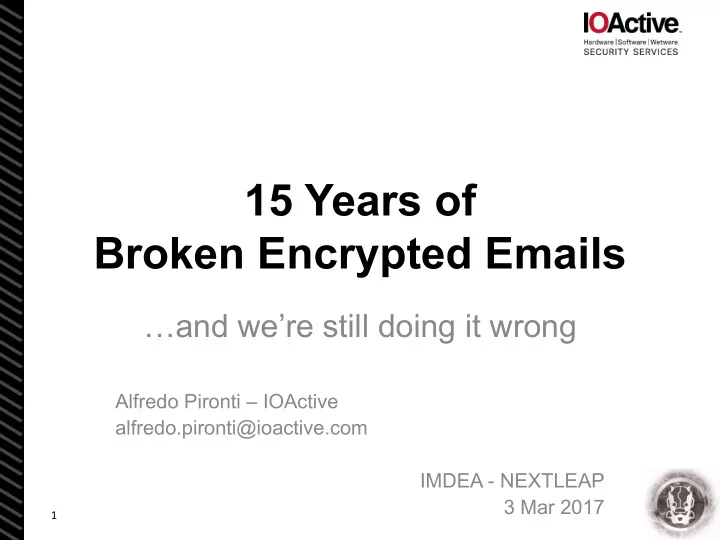

15 Years of Broken Encrypted Emails …and we’re still doing it wrong Alfredo Pironti – IOActive alfredo.pironti@ioactive.com IMDEA - NEXTLEAP 3 Mar 2017 1
Agenda • Intro to OpenPGP • An efficient attack on signatures • And other well known attacks • Application to encrypted emails • Proposing a fix • Future work and conclusion 2
Intro to OpenPGP 3
The OpenPGP Standard • RFC 4880 (2007) • How to perform encryption • Encrypt; Sign; Sign & Encrypt • RFC 3156 (2001) • How to use OpenPGP to encrypt email • Widely used • Email, password managers, git… • Design is about 20 years old 4
OpenPGP Sign & Encrypt s [m] s sign sym enc m m’ {k} r <m’|[m] s > k compress k r asym enc 5
OpenPGP Sign & Encrypt Properties: • Probabilistic encryption • Efficient for large messages • Efficient for multiple recipients 6
Multiple Recipients s [m] s sign sym enc m m’ k {k} r1 {k} rn … {k} r <m’|[m] s > k compress r 1 … r asym enc r n 7
An Efficient Attack on Signatures and Other Well-Known Attacks 8
Surreptitious Forwarding [1] • A à B: { [ “I love you” ] a } b • B à C: { [ “I love you” ] a } c • A à B: { [ “sales plan” ] a } b • B à C: { [ “sales plan” ] a } c • A à B: { [ “I owe you 10K” ] a } b • B à C: { [ “I owe you 10K” ] a } c [1] Davis, D.: Defective sign & encrypt in S/MIME, PKCS#7, MOSS, PEM, PGP and XML. In USENIX 2001 9
Efficient Surreptitious Forwarding s [m] s sign sym enc m m’ k {k} r1 {k} rn … <m’|[m] s > k compress r 1 … asym enc r n PoC tool available on demand 10
Message Compression • Seriously? • “OpenPGP implementations should compress the message after applying signature but before encryption” – RFC 4880 • Remember CRIME attack on TLS? • Compression leaks information about entropy of plaintex 11
Application to Encrypted Emails 12
RFC 3156 – Email Sign & Encrypt Msg Header From: <alice@example.com> To: <bob@example.com> Subject: Encrypted Email Msg Body Encrypted content Sample email content for Bob <encoded binary Msg Body Signature by Alice encryption> <encoded binary signature> Alternatively, use the OpenPGP Sign & Encrypt scheme 13
Tampering with Email Headers • From: • Confidentiality traded for routing purposes • Could use pseudonyms • Should be signed • To: • Confidentiality traded for routing purposes • Could use pseudonyms • No signature makes encryption pointless! • Subject: • Not encrypted: strong contrast with user expectation • Hard to encrypt in a backward-compatible way • Reply-To: • Please, re-encrypt the whole thread with the attacker’s key! 14
Tampering with Reply-To: in Practice • Sent several encrypted test reports to “secure@” of software vendors • Added an attacker-controlled Reply-To: address • Avoiding the social engineering aspect: Reply-To: address totally different from sender’s • Attacker got more than 50% responses • One informed him that the message was signed, but not encrypted • One replied to both, asking which address should be used • Some answers were not signed • Caveats • Small sample: < 10 recipients • Test data did not look critical; no rise in attention 15
Proposing a Fix 16
AEAD for OpenPGP • Authenticated Encryption with Additional Data • Additional data are signed, but not encrypted • Examples in the symmetric world: AES-GCM • Email headers are AD 17
An OpenPGP-compatible Scheme • Enc(s,r,m,ad) • Sign-encrypt-sign OpenPGP m c’ sign-encrypt r OpenPGP c Key Identifiers sign s ad 18
Details and Properties • On decryption, inner and outer signature keys must match • Generalization of Sign-Encrypt- Sign scheme proposed by Davis [1] • Accounts for AD • Fits into the OpenPGP standard • Compression is disabled • Preserves probabilistic encryption • Provides CTXT-INT 19
Formal Verification • ProVerif, symbolic model 20
Application to Emails • Headers are AD • Must agree on signed headers order, or use extra header • Watch out for outer signature stripping (don’t allow legacy email encryption) 21
Future Work and Conclusion 22
End-to-End Email Encryption • Extension for in-browser email encryption • From the docs: • Implements RFC 4880 • Headers unencrypted (nor signed?) • RFC 3156 not currently supported • Uses elliptic curves • Centralized key distribution with transparency • Not yet ready for general use 23
Conclusion • Mismatch between user expectations and cryptographic properties • Relying on dated standards with known design flaws • Practical attacks are possible • AEAD with backward compatibility is possible • New momentum in secure email 24
Thank you! Questions? 25
Recommend
More recommend